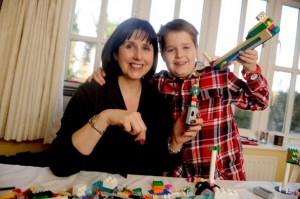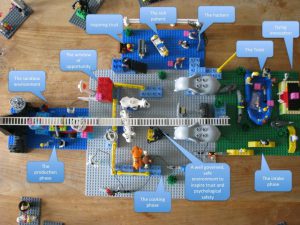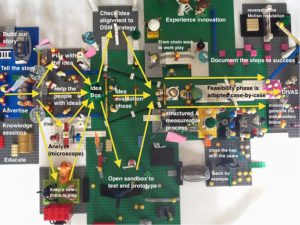-
Marko Rillo wrote a new post 10 years, 3 months ago
During recent days, a couple of new Slideshares have been created on Lego Serious Play methodology. The first one is created by the Assistant Professor Arindam Basu of University of Canterbury at Christchurch, New Zealand. In his presentation he combines design thinking with Lego Serious Play approach and demonstrates how the combination can be used in order to achieve flow in solution finding process.
Another Slideshare is in French language. Published by a SlideShare user “Chinkie75” – it shows some photos of tower and bridge building exercise and a number of metaphors as well.
-
Marko Rillo wrote a new post 10 years, 3 months ago

The following article was published on the website of Independent Free Press Canada.Chances are you grew up with LEGO. Perhaps it was your favourite toy, or a building tool that invoked your imagination to
-
Marko Rillo replied to the topic In search for THE definition in the forum
 Serious Play Pro Forum 10 years, 3 months ago
Serious Play Pro Forum 10 years, 3 months agoPatrizia and Per,
Thanks to both of you for a great discussion. It might be indeed a good idea to gather in September and even spend some time on definition building. However, if we are unable to define the LSP for our purpose more precisely then I would say that there is nothing wrong with that either. If we are not too strict in our expression…[Read more]
-
Jim Hwang posted an update in the group
 Serious Play Forum 10 years, 3 months ago
Serious Play Forum 10 years, 3 months agoMay I have your experience if I want to use LSP starter kit only for 25-30 people in 1-1.5 hr to make group describe current team profile and ideal vision? It is part of full day team building or leasership workshop.
-
Martin van Dijken replied to the topic VAT? in the forum
 Serious Play Pro Forum 10 years, 3 months ago
Serious Play Pro Forum 10 years, 3 months agoAh, 1 question sort of answered. I just received an invoice from Lego Denmark. The strange thing is that the invoice is in Dutch, with the Dutch VAT percentage (21%, DK apparently has 25%) and the bank that is listed is a Dutch bank.
Getting more and more confused :-)
-
Martin van Dijken started the topic VAT? in the forum
 Serious Play Pro Forum 10 years, 3 months ago
Serious Play Pro Forum 10 years, 3 months agoHey all,
After receiving my certification from Per, I am now every excited to get started on my first workshop. I ordered 10 starter kits and a box of exploration kits from the Lego online store. It has been shipped, so happy about that.
Question though: how does it work with VAT? There is no VAT mentioned on the invoice and I can’t even tell…[Read more]
-
Marko Rillo wrote a new post 10 years, 3 months ago

After the post where the Lego Serious Play Starter Kit (art.no. 2000414) was unpacked, recently another video has been uploaded to YouTube where a Dutch facilitator Rick Lindeman demonstrates the contents of the -
Patrizia Bertini replied to the topic In search for THE definition in the forum
 Serious Play Pro Forum 10 years, 3 months ago
Serious Play Pro Forum 10 years, 3 months agoI was thinking exactly the same thing :)
It could be a very interesting experience, given the different and divergent applications we comply LSP for.
So, trying to converge may be an interesting exercise!Cheers,
Pat -
Per Kristiansen replied to the topic In search for THE definition in the forum Serious Play Pro Forum 10 years, 3 months ago
hi Patrizia
Indeed
Could perhaps also be topic for a building exercise at a break out session at the LSP days later this year…
A presto
Per -
Patrizia Bertini replied to the topic In search for THE definition in the forum
 Serious Play Pro Forum 10 years, 3 months ago
Serious Play Pro Forum 10 years, 3 months agoThanks Per!
Well, the moment you ways it’s a process, you define it, yet it’s vague.
I feel LSP is a kind of elephant – hard to describe but easy to recognise when experienced.LEGO is not enough to define it in its essence, application varies. core values receive different emphasis…
It’s like the tower/bridge exercise: we all know what those o…[Read more] -
Per Kristiansen replied to the topic In search for THE definition in the forum Serious Play Pro Forum 10 years, 3 months ago
hi Patrizia
Your question is far from stupid, however it may have two sides to it:Do you mean what defines something as LEGO SERIOUS PLAY – in that case we would often turn to the core process. If one does not adhere to the core process, then it is not LSP
Do you mean defining what it does or is, ie a method etc – in this case we often talk…[Read more]
-
Patrizia Bertini started the topic In search for THE definition in the forum
 Serious Play Pro Forum 10 years, 3 months ago
Serious Play Pro Forum 10 years, 3 months agoHello everyone!
The premise: I recently went to a workshop that encouraged people to ask stupid questions. So, I have been starting asking stupid questions and build on them.
So, despite being engaged with the bricks by 5 years already, I have just realised that I could not find THE official definition of LSP.
There are amazing definition out…[Read more]
-
Patrizia Bertini wrote a new post 10 years, 3 months ago
 I recently had the pleasure of facilitating a LEGO SeriousPlay workshop at Hot Source. One of the participant, Marek Pawlowski, shared his experience.
I recently had the pleasure of facilitating a LEGO SeriousPlay workshop at Hot Source. One of the participant, Marek Pawlowski, shared his experience.
As a facilitator, used to describe the method, it was refreshing and an immense pleasure to know that he experienced exactly what I always described when I talk about the power and benefits of LSP. Thank you @Marek for such an amazing post!
Improvement requires change, whether that happens gradually through iteration or in big leaps through sudden sparks of creativity. This is true of improving anything, from companies to individual products. It’s something I think about a lot in the context of the MEX initiative, which is, at its heart, about helping people to improve digital experiences. We are always looking for new ways to equip people to make good changes to the user experience of the products they’re designing.
The difficult part is that ‘improvement’ is very subjective. Realistically, you can only ever hope the changes you make will ‘improve’ things for most of your users. There simply is no such thing as an improvement which is objectively better for everyone.
However, the application of objective processes to achieve a creative result can help increase the chance your subjective improvements will be applicable to the largest possible number of users. This is why we try different techniques at MEX events, from physical exercises – like thinking about how the movements most natural to your body might transpose into digital interfaces – to low-fi, fast-paced model making.
While I’ve organised many of these different facilitations over the years, I was intrigued by the opportunity to be participant for a change, and in an exercise I’d never tried before, using Lego for serious play, facilitated by Patrizia Bertini (@legoviews). It was hosted by UX agency Foolproof (@foolproof_ux) and organised by Hot Source(@hsnorwich), a networking group in Norwich, UK (for our international readers: a small city in the East of the country – the significance of which will become apparent later).
Patrizia’s method is derived from the Lego Serious Play technique and qualification, formalised by Robert Rasmussen – formerly a product development director at Lego, in 2002. The premise is that by occupying participants’ hands with a physical task like assembling Lego blocks, you can help them to think and discuss more creatively about other, often abstract problems. In addition, the Lego itself provides an accessible medium to give physical form to your opinions.
Although the participants did not know this at the start, the purpose of the evening was to identify the challenges facing the creative industry in Norwich and propose a solution. However, Patrizia did not reveal this until the end, and instead focused her efforts on immediately engaging a relatively large group (15 participants, she usually works with 5 – 10).
Everyone sat around a large table, covered in Lego, and she explained a few ground rules: everyone who starts must finish (i.e. you can’t disappear half way through to make a phone call) and if you need to leave for a bathroom or unexpected break the rest of the group will pause and wait for you. Both of these rules emphasised that although we’d be building things as individuals, we were participating in a group challenge.
All of the actual Lego building challenges – from constructing a tower to riffing on what it means to be creative – were very rapid, 4 minutes each at most. This pace forced everyone to create without hesitating and, of course, the results were diverse, but crucially no one felt held back by fear of their medium.
After each round of building, Patrizia would ask each person in turn about their model and – significantly – to answer only with reference to the model itself. In this way, the models became the filters which allowed people to address the questions without bringing their own personal baggage into the group.
It was a neat way of solving one of the biggest problems in time-limited workshops: time wasted by everyone communicating their existing views and personality, usually by a round of ‘Hi, I’m Marek and I do XYZ’ style intros. The whole point of a creative workshop like this is to give people a license to think outside their existing roles, but most start with the standard, tedious round of intros, which only serve to reinforce who you are when you start the workshop rather than who you could be when you come out of it.
Patrizia’s skillful facilitation bypassed this stage, yet everyone around the table still knew more about everyone else’s personality by the end. It also meant participants could stay focused on responding to the specific building challenges she posed.
We went through several rounds of building, breaking down the models each time, until she started to guide us towards more specific questions, like making a representation of the problems facing the creative industries in Norwich. After we’d each explained these challenges, she asked us to keep the models and adjust them to show how we’d solve the problem we’d identified.
The final stage was to come together in a group by each placing a red Lego brick on someone else’s model which we thought represented a good solution and discussing why. Then, working together, we had to agree which elements of the solution we’d contribute to a final proposal – in the form of a Lego model – but only adding items which met with universal agreement.
By this stage, about two hours in, it was obvious a group of relative strangers were able to discuss, collaborate and work through problems because of the way Patrizia’s process had broken down traditional barriers and overcome the usual group dynamics in which a small number dominate the session. It would have been remarkable for this alone – the ability to get everyone meaningfully involved – but also for the way time seemed to fly by, without anyone feeling the need to leave or be distracted by their phone.
So, what of the result itself? After all, however interesting the process, the real test is whether it produced a useful outcome.
It left me with several conclusions:We were discussing Norwich, but you could substitute any number of small, regional cities I’ve visited in the UK, US and Europe: no one is alone in questioning the effectiveness and future of their creative industries.
Communities, of shared practice, and of moral support are at the heart of any industry and nurturing them is always a good starting point (it was interesting to hear Thomas Foster, outgoing head of UX at a large bank saying something similar about communities of practice within large organisations at the March 2014 MEX).
Connections are vital, both in the sense of encouraging individuals to connect with each other to share experiences, and in the physical sense: good links enable the import and export of talent.
Every regional city has one or two large ‘anchor’ clients which dominate the local business scene. This has benefits, but can stifle creativity and hold back expansion. Look outwards and recognise the opportunities in working with a diverse range of smaller clients.
(and yes, burying Alan Partridge was also mooted!)The results did not necessarily break new ground in the content of the answers, but the efficiency with which they were arrived at, while still being sufficiently collaborative that everyone was able to contribute was impressive. The method was also effective for the way it maintained momentum and kept group members interested in what each other were doing. Lego alone did not achieve this – indeed, you could have substituted any number of other materials – it was primarily down to the skill of the facilitator, who maintained an admiral balance of discipline, fun and inquiry.
Patrizia Bertini has also created a series of video interviews with designers and architects, where she uses Lego play as a key part of her interview technique to help the participants open up the discussion. Recommended viewing. -
Simon Horan posted an update in the group
 Serious Play Forum 10 years, 3 months ago
Serious Play Forum 10 years, 3 months agoLooking to use LSP in an international conference of 150 to 200 people in China – any previous experience of do’s, don’ts, avoids, musts etc. gratefully received
-
Hi Simon, I am curious about your challenge. Here are some of my questions: Is this a conference or a workshop? If it’s a conference, how will you be using LSP? Will you be demonstrating the methodology or do you have specific business objectives to address? Will all 150 conference participants be taking part in the LSP activity? How many…[Read more]
-
Hi Simon. I agree with Eli. Its very important to understand the overall output desired. If it is a reasonably complex question then you need a trained facilitator and assistant facilitators for every 8 to 12 pax. Alternatively train a person at each table as a facilitator for the day. I have done both. Just did a workshop on collaboration and…[Read more]
-
Simon, adding to the above (with which I am perfectly aligned), my experience with large groups, whether it is an intro to LSP or an actual delivery, is that music should be avoided, relatively small groups (6 per table) makes it easier to align, that sharing rounds are shorter, skills building is as always important, and finally that each…[Read more]
-
-
Marko Rillo wrote a new post 10 years, 4 months ago
Dotti Toellner and Cori Moore Video on Lego Serious Play Facilitation workshop at Lift 2014 conference. They wrote about the event the following.
What happened at Lift14: Well, we sure had some serious fun – it’s amazing what you can do with such energetic and inspiring participants! The fully booked session kicked off with some skill building exercises, teaching our lively liftonians how to (literally) build metaphors, express abstract ideas with 3D models and collaborate through storymaking. Then the real work started as we addressed the question: “What does it take to be a change agent”. (We couldn’t believe how committed these guys were – talk about “flow moments”.) Putting their new skills into action, our lifters experienced rapid action prototyping and shared sense making as they probed and encouraged their fellow team members, drawing out meaning with plenty cheers and laughter!
They also reflected upon their experience at their blog and at their company website.
Doerte ‘Dotti’ Toellner is co-founder and managing director of Point-Blank International. In nearly two decades as a qualitative researcher, design thinker and change agent she has founded two companies and travelled the world on the behalf of ‘her’ brands. Catching sparks and crafting new ways of looking, thinking & doing keeps her inspired and passionate – in research, design, innovation & life in general. Make sure you set aside some time to chat with her about her hobby horses, such as 5 senses research, haptic think and the role of magic in the qualitative approach!
Cori Moore is stationed at Point-Blank’s idea workbench and communication hub, better known as Spark & Craft. A multitasking octopus, she devotes her time to running workshops, attending conferences and events, writing blogs & articles, tweeting, occasionally doodling and bringing new sparks of inspiration & people into the company. A cultural sponge, with a passion for trying new things, her bag of tricks incorporates her experience in the diverse fields of research, communication, event management & mixology – she can make a mean cocktail if you ask her nicely.
-
Marko Rillo wrote a new post 10 years, 4 months ago
The following post on how Lego Serious Play is not just a game was written by the Liquid Agency Chief Creative Officer Alfredo Muccino
Lego Serious Play is a hands-on, experiential process designed to
-
Marko Rillo wrote a new post 10 years, 4 months ago
 An interesting post from Get West London about the use of Lego Serious Play in therapy
An interesting post from Get West London about the use of Lego Serious Play in therapyA Harefield woman is among a new breed of therapists encouraging grown men and women to stop working and start playing –
-
Marko Rillo wrote a new post 10 years, 4 months ago
I found this 2 year old post about Lego Serious Play by Agile Partnership consultant Ellen Grove from her blog. There is also a great team facilitation case study that includes an interesting responsibility game –
-
Marko Rillo wrote a new post 10 years, 4 months ago
 LEGO Serious Play Transcript by Massimo Mercuri
LEGO Serious Play Transcript by Massimo MercuriLego Serious Play facilitator and our community member Massimo Mercuri has published an interesting post on LSP Facebook group showing how he has transcribed the models that they have built. It is an interesting concept and can add useful perspective to the client. Probably a good idea to report back upon the LSP session. Look at the two pictures closely. Have you done something similar – what do you think of his approach?
-
Sjra Puts posted an update 10 years, 4 months ago
After my training in May from Robert Rasmussen I will conduct my second LEGO® SERIOUS PLAY ® session tomorrow. Exciting!
- Load More


 Become a LEGO Serious Play facilitator - check one of the upcoming training events!
Become a LEGO Serious Play facilitator - check one of the upcoming training events!
Hi Mark,
sorry for the late reply!
I would make a distinction between LSP core and its derivative applications. Legoviews (which I have been doing in several context different from the initial experiments in Palestine) in NOT LSP, it’s a derivation as it lacks many elements of a workshop.
Perhaps we don’t need a definition, but perhaps defining…[Read more]